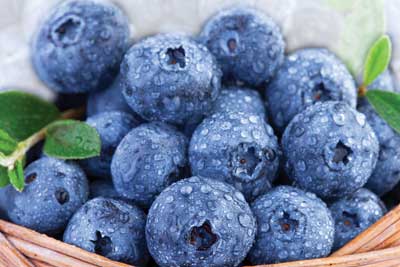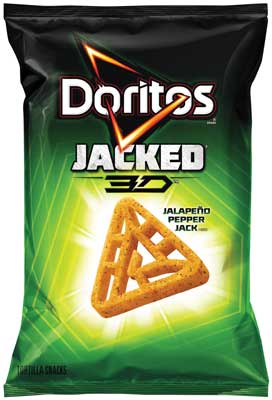Wet UV processing for Blueberries; Fat considered sixth taste
NEWS
 Treating blueberries with wet UV processing
Treating blueberries with wet UV processingApplying ultraviolet (UV) light to blueberries submerged in water can be more effective than using a dry UV treatment, according to a study published in the Journal of Food Science.
UV light can provide antimicrobial effects when used on food infected with bacteria such as Salmonella, but a resulting shadowing effect has limited its use. In this study, researchers tested using UV processing in agitated water to treat blueberries that were dip- or spot-inoculated with E. coli and Salmonella. Though dip-inoculated blueberries were more difficult to decontaminate, the wet UV method generally showed higher efficacies than dry UV treatment in both cases.
The researchers also tested the efficacy of combinations of wet UV with three chemicals. Inoculated blueberries were UV-treated while being immersed in agitated water containing 100 parts per million sodium dodecyl sulfate, 0.5% levulinic acid, or 10 parts per million chlorine; adding these chemicals did not significantly enhance the effects of the wet UV treatment. Therefore, the authors conclude that wet UV treatment shows potential as an alternative to chlorine washing for blueberries and possibly for other fresh produce.
USDA, Microsoft launch food challenge
The U.S. Dept. of Agriculture partnered with Microsoft to create the Innovation Challenge, which aims to find ways to achieve better food resiliency by examining how climate change will affect the U.S. food system. The contest asks participants to develop and publish new applications and tools to analyze multiple sources of information about the nation’s food supply, including USDA data sets hosted on Microsoft’s cloud-computing platform, Microsoft Azure.
“Through this partnership with Microsoft, we are now putting [USDA] data into the hands of people who can help us derive new insights to address factors that threaten our ability to feed a growing global population,” says Agriculture Secretary Tom Vilsack. “This offers very exciting possibilities, and I look forward to seeing the new tools that contest participants develop.”
A total of $60,000 in prizes is available, including a top prize of $25,000, for applications that make use of the USDA data and provide actionable insights to farmers, agriculture businesses, scientists, or consumers. Microsoft is also providing cloud-computing awards to university researchers and students who want to take part in the challenge. Entries are due Nov. 20, 2015, and winners will be announced in December 2015.
FDA proposes further Nutrition Facts revisions
The U.S. Food and Drug Administration announced that it is proposing additional revisions to the Nutrition Facts label for packaged foods that would require the percent daily value (%DV) for added sugars be declared. This %DV would be based on the recommendation that the daily intake of calories from added sugars should not exceed 10% of total calories.
“The FDA’s initial proposal to include the amount of added sugars on the Nutrition Facts label is now further supported by newly reviewed studies suggesting healthy dietary patterns, including lower amounts of sugar-sweetened foods and beverages, are strongly associated with a reduced risk of cardiovascular disease,” the FDA wrote in an update.
Additionally, the FDA is proposing to revise the footnote on the Nutrition Facts label explaining %DV to help consumers better understand the concept. The FDA is accepting public comments until Sept. 25, 2015.
Fat considered sixth taste
According to new research from Purdue University, fat should be considered the sixth basic taste, joining sweet, salty, bitter, sour, and umami.
In the study, “Oleogustus: The Unique Taste of Fat,” which was published online in Chemical Senses, researchers asked 102 participants to sort solutions containing a compound that tasted salty, sweet, umami, bitter, sour, or fatty into groups based on similar taste qualities. Although testers initially sorted fatty samples with bitter ones, when they were asked to differentiate between bitter, umami, and fatty samples, the participants were able to group the fatty acids together separately from the others.
“The taste component of fat is often described as bitter or sour because it is unpleasant, but new evidence reveals fatty acids evoke a unique sensation satisfying another element of the criteria for what constitutes a basic taste, just like sweet, sour, salty, bitter, and umami,” says Richard D. Mattes, distinguished professor of nutrition science at Purdue. “By building a lexicon around fat and understanding its identity as a taste, it could help the food industry develop better tasting products and with more research help clinicians and public health educators better understand the health implications of oral fat exposure.”
The term “oleogustus” was chosen based on the Latin root words “oleo,” which means oily or fatty, and “gustus,” which refers to taste.
Datamonitor shares snack trends
Snacking isn’t a category, it’s a behavior, said Tom Vierhile, innovation insights director for Datamonitor Consumer, during a recent webinar that explored trends in snack product development. During the presentation, he provided information about the growing snack category and examined some of the factors driving new product development.
According to Vierhile, savory snacks accounted for $93 billion of global spending in 2014 alone, and the category is expected to grow at a 4.2% compound annual growth rate from 2013 to 2017. Globally, three out of four people snack daily, with 55% doing so at home. Consumers are increasingly looking to snacks as a form of weight management, and they tend to be drawn toward snacks that can satisfy their cravings while providing fewer calories and less fat, carbohydrates, and sugar.
 One trend that answers these desires is what Vierhile calls “thin is in,” a general slimming down of cookies, crackers, and pretzels to deliver amplified crunchiness and flavor with fewer carbs and calories. These smaller snacks have more of a female appeal, as around the world, 50% of women say they are trying to lose weight. Air-filled snacks such as Doritos Jacked 3D function similarly, offering a satisfying crunch without the calories. Meat snacks, such as Epic meat bars and jerky, answer consumers’ desire for added protein, and squeezable pouches provide a convenient way to consume fruits and vegetables with the perception of lower sugar content. Vegetables, meanwhile, are finding their way into the base of some snacks, such as broccoli and beet chips, and fruits match up with nuts, seeds, and grains in clusters that answer demands for clean label snacks.
One trend that answers these desires is what Vierhile calls “thin is in,” a general slimming down of cookies, crackers, and pretzels to deliver amplified crunchiness and flavor with fewer carbs and calories. These smaller snacks have more of a female appeal, as around the world, 50% of women say they are trying to lose weight. Air-filled snacks such as Doritos Jacked 3D function similarly, offering a satisfying crunch without the calories. Meat snacks, such as Epic meat bars and jerky, answer consumers’ desire for added protein, and squeezable pouches provide a convenient way to consume fruits and vegetables with the perception of lower sugar content. Vegetables, meanwhile, are finding their way into the base of some snacks, such as broccoli and beet chips, and fruits match up with nuts, seeds, and grains in clusters that answer demands for clean label snacks.
Other innovative products are drawing on interesting sensory appeal to attract new consumers. Frozen candy bars, microwavable sunflower seeds, and heat-and-eat potato chips change the way consumers interact with traditional foods, and contrasting flavor combinations, such as olive and Chianti and Camembert and quince, add a level of sophistication to snacks such as potato chips and crackers.
What’s new with food companies
• AAK announced the groundbreaking of its new innovation center, which will be located in Edison, N.J., and will allow the company to collaborate and codevelop with its customer partners.
• The quality assurance teams at four Bay State Milling Co. mills have been recognized with the AACC International Analytical Accuracy Award for 2014.
• Gamay Foods, a supplier of dairy flavor systems, custom seasonings, and sauces, opened a new innovation center in New Berlin, Wis.
• Ganeden formed a strategic alliance with Sensus America to create Frutalose PRO, a prebiotic chicory root fiber syrup blended with the probiotic GanedenBC30.
• Hinoman has been granted self-affirmed generally recognized as safe status for its mankai ingredient, a whole-protein vegetable ingredient with high nutritional value.
• Ingredion agreed to acquire Kerr Concentrates, a privately held producer of natural fruit and vegetable concentrates, purees, and essences.
• Kraft-Heinz will move its headquarters to Chicago.
• Lesaffre Human Care’s patented strain of Saccharomyces cerevisiae CNCM I-3856, ibSium, was granted the following health claim by Health Canada: “Helps to reduce abdominal pain and discomfort associated with irritable bowel syndrome (IBS).”
• Mars Chocolate North America will invest an additional $100 million into its Topeka, Kan., site to create a new state-of-the-art 90,000-square-foot facility.
• Mérieux NutriSciences renamed its North American flagship laboratory in Crete, Ill., the Dr. John H. Silliker Solution Center in honor of the late founder of Silliker Laboratories.
• Mondelēz International completed the acquisition of an 80% stake in Kinh Do, Vietnam’s leading snacks business. It also announced an investment of more than $130 million in its North American biscuits business, installing four state-of-the-art manufacturing lines at the company’s production facility in Salinas, Mexico.
• Nestlé will build a new factory in Dubai to produce coffee and culinary products for distribution throughout the Middle East.
• Prinova announced a partnership to become the exclusive North American distributor for IN Ingredients, a worldwide supplier of innovative scientifically researched branded ingredients.
• Roka Bioscience announced that its Atlas Listeria Environmental Detection Assay received AOAC Performance Tested Methods certification from the AOAC Research Institute.
• SK Food International earned Safe Quality Food certification at its processing facility located in Moorhead, Minn., and was granted an “excellent” audit rating.
• Takasago de Mexico opened its new Creative Center for Flavors and Fragrances in Tlalnepantla, Mexico.
• Watson-Marlow Fluid Technology Group acquired the MasoSine sinusoidal pump manufacturing and distribution business from PRIMIX Corp. in Japan.
• The WhiteWave Co. agreed to acquire Wallaby Yogurt Co., a manufacturer and distributor of organic yogurt products.
 Melanie Zanoza Bartelme,
Melanie Zanoza Bartelme,
Associate Editor
[email protected]
